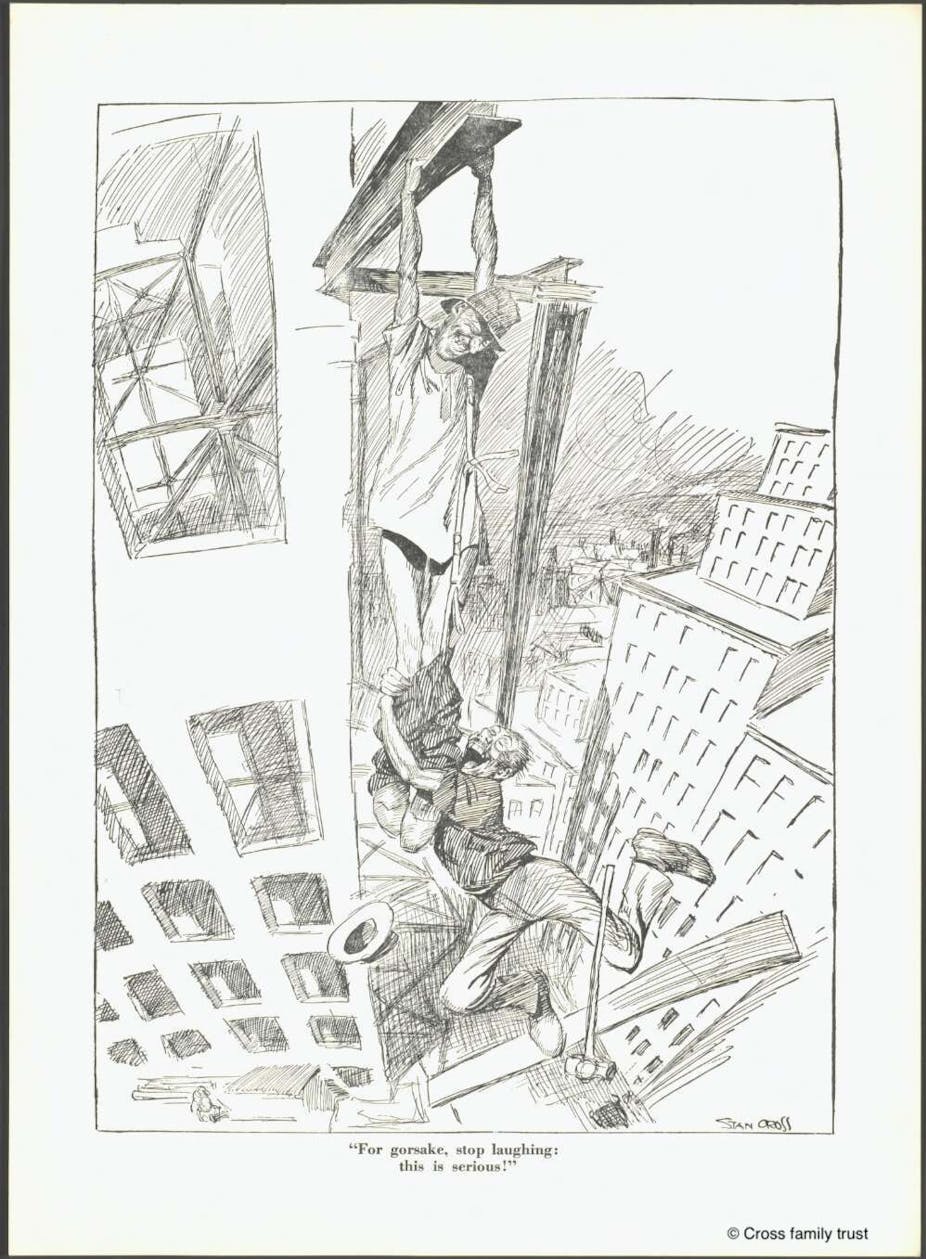A man hangs, precariously, high above the street, holding onto the girder of an unfinished skyscraper. Around his ankles, a second man holds on for dear life.
This is no scene of drama, but hilarity. The second man has pulled down the first’s pants in his desperation to hold onto life, and is lost in laughter. Grimacing, the first man growls:
For gorsake, stop laughing: this is serious!
Published in 1933, this is Australia’s most famous cartoon, drawn by Stan Cross.
Labelled an instant classic, bizarrely, this cartoon has twice been lost. Not only was the original artwork missing for eight decades, the National Library of Australia’s Trove database holds no record of its first newspaper publication.
These disappearances – and the diligent detective work required by those who recovered the cartoon – demonstrate deep flaws in the way Australia maintains our rich cartoon heritage.
Lindsay Foyle, longtime editorial cartoonist and honorary historian of the Australian Cartoonists’ Association, has been on the elusive cartoon’s trail for decades. With him, we recently published what we hope is the definitive account of its attempts to dodge the cartoon detective and escape the national record.
The search for the original
“Stop laughing” was published on July 29 1933 in Smith’s Weekly, known for its anti-authoritarian and nationalist stance.
Smith’s was a key part of a raucous Australian cartooning culture, then dominated by weekly publications whose cartoons provided both social commentary and political satire.
The production process started with a reader suggestion given to a young artist, and Smith’s lead cartoonist, Stan Cross, setting out to mentor him.
Cross became engrossed and finished the artwork and reworked the accompanying joke himself. Smith’s advertised and sold copies of the cartoon to meet huge public demand – inadvertently creating many false leads in the eventual search for the artwork.
Despite its instant popularity, the original artwork soon disappeared. Foyle’s many attempts to track it down, alongside ex-Smith’s staff and other cartooning historians were unsuccessful until 2014.
That year, at a community market on the central coast of New South Wales, a man approached cartoonist Rob Feldman to ask if he had heard of Cross’ cartoon.
It emerged Cross had given the original to Smith’s company secretary Arthur Ayers soon after publication. It had remained with the family for nearly 80 years.
Foyle and leading amateur comics scholar Nat Karmichael went on an expedition, and immediately recognised this as the original. They put the owner in contact with the National Library of Australia, where the restored artwork is now housed.
Read more: In praise of the cartoonist – solitary, studious and searing
And the search for the digital
While tracking down the original is vital in art-historical terms, the most significant state of an editorial cartoon is really how it was first published in print.
From this perspective it is the second, digital disappearance of “Stop laughing” that raises the biggest concerns about Australia’s cartoon archive.
Original copies of historical newspapers are challenging to access, but in 2022 we expected it would be easy to find a digital copy of the cartoon through Trove, which digitises Australian newspapers and magazines.
But we found no sign of the cartoon at all in the July 29 1933 copy of Smith’s, or on any nearby date.
The first appearance of Cross’ famous cartoon is not until August 12, labelled “reprinted by request” and advertising copies for sale.
How had “Stop laughing” gone missing again? Was it all a marketing hoax from the 1930s – was it really only published for the first time in August, the requests for reprints being fake?
The real answer is almost as interesting. It was due to a minor but consequential theft from the newspaper collection of the State Library of New South Wales.
When transferring their print copy of the July 29 1933 Sydney edition to microfilm later in the 20th century, it had been noted by a careful archivist that pages three and four were missing, and so they were substituted with pages from the Queensland edition.
This new, hybrid edition then made its way onto Trove.
It was then “Stop laughing” disappeared from Trove’s digital archive. In fact, it had never been there.
The interstate editions – printed earlier to allow for transportation time – had published the cartoon on page 16. This might not have been an issue had the cartoon been published on the same page as in the Sydney version. However, it seems in the hours between editions, the editor decided to move this “instant classic” forward, and to size it up for greater effect. The substitution of pages three and four from Queensland created a hybrid with no trace of the cartoon.
A search of what is possibly the last surviving intact copy of the original NSW edition – held at the State Library of South Australia – allowed us to rediscover “Stop laughing” as it was originally published, and as seen by no one for decades.
It sits proudly on page three, larger than any other single-frame cartoon we’ve seen printed in Smith’s.
Preserving the archive
Australians pride themselves on their history of editorial cartooning.
We take the anti-authoritarian, larrikin nature of the humour, the relative freedom with which cartoons are published, and the good humour of those lampooned as signs of the health of our democracy.
And yet, we are surprisingly careless with our cartoons. There is no real rhyme or reason to what we keep, where we keep them, or how easy they are to find.
The dual disappearances of “Stop laughing”, decades apart, expose the patchiness and inaccessibility of Australia’s cartooning archive. There is an urgent need for a solution that develops and sustains the national collection, to preserve and make accessible our rich national cartoon heritage.

